|
Wild, Weird, and Wonderful—
The Lost World of the Midway
by Bob Brooke
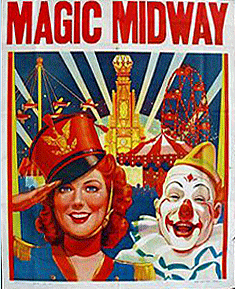 The old-time carnival midway, with its freak show offering illicit
thrills and games that looked easy but seemed impossible to win isn’t
the same as it once was. Loud music and flashing lights have replaced
the carny's shouted come-on. Government regulators have cracked down on
the shady games. And the freak show has been shut down by politically
correct attitudes. The old-time carnival midway, with its freak show offering illicit
thrills and games that looked easy but seemed impossible to win isn’t
the same as it once was. Loud music and flashing lights have replaced
the carny's shouted come-on. Government regulators have cracked down on
the shady games. And the freak show has been shut down by politically
correct attitudes.
The American midway as it’s known today had a rather circuitous
beginning. The bizarre world of freak exhibits and games began just
after the War of 1812 with a farmer from Somers, New York, known as
Hackaliah Bailey. His brother, a sea captain, bought a female African
elephant for $20 and sold it to Bailey for $1,000.
The captain brought the elephant over from England and deposited her at
Sing Sing, the nearest river town to Somers. Bailey walked the animal,
which he called Old Bet, to his home 56 miles away. He exhibited the
elephant in tavern yards and barns for a small fee and began to make a
profit. His success encouraged others to invest in unusual animals for
exhibition and take them on tour, thus beginning the traveling
menagerie, a forerunner of today’s midway.
P.T. Barnum
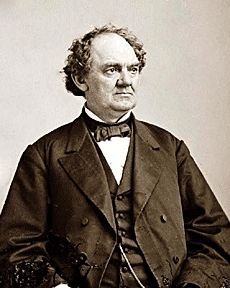 P.T. Barnum, the master of the humbug, was the next to bring the midway
closer to fruition. Born in 1810 in Bethel, Connecticut, only 20 miles
from where Bailey exhibited Old Bet, he eventually met Bailey while
running a fruit stand in Bethel. And Bailey’s inventiveness with Old Bet
made a lasting impression. P.T. Barnum, the master of the humbug, was the next to bring the midway
closer to fruition. Born in 1810 in Bethel, Connecticut, only 20 miles
from where Bailey exhibited Old Bet, he eventually met Bailey while
running a fruit stand in Bethel. And Bailey’s inventiveness with Old Bet
made a lasting impression.
In 1841, Barnum purchased Scudder’s American Museum on Broadway in New
York City. He exhibited “500,000 natural and artificial curiosities from
every corner of the globe” and kept traffic moving through the museum
with a sign that read, “This Way to the Egress”–“egress” was another
word for exit, and Barnum’s patrons would have to pay another quarter to
reenter the museum.
Some of his most famous attractions were Joice Heth, billed as George
Washington’s 161-year-old nurse and the “Feejee Mermaid,” a monkey's
body grafted onto a fish and embalmed which a Boston seaman purchased
near Calcutta. Even though belief in the mermaid’s authenticity was
mixed, no one doubted Barnum’s ability to capture the imagination of the
public. Barnum knew how much people wanted to see the rare and exotic in
their own species as well as others.
By 1865, Barnum was the biggest promoter of individual attractions the
world had ever known, but he was at heart an exhibitor of curiosities,
human and otherwise.
The Beginnings of the Modern
Midway
The modern midway began in the U.S. with the 1893 Columbian Exposition
in Chicago with the invention of electricity. The midway, with its wide
array of rides and concessions, was a huge success. The following year,
Capt. Paul Boyton borrowed the midway concept and opened the world's
first modern amusement park, known as Paul Boyton's Water Chutes, on
Chicago's South side. Unlike the primitive trolley parks that sprang up
outside towns and cities across the nation, the Water Chutes was the
first amusement park to charge admission and use rides as its main draw
rather than picnic facilities or a lake. The success of his Chicago park
inspired Boyton to open a similar facility at the fledgling Coney Island
resort in New York in 1895.

The midway grew tremendously over the next three decades. Royal American
was the biggest and best, traveling the continent to all the major fairs
and festivals. Traveling midways, known more commonly as carnivals, set
up in vacant lots throughout the country.
Games of Chance
The idea for games of chance came from Europe. There, outdoor gardens
featuring live entertainment and games had entertained people for
centuries. Huge gaming wheels, featuring fancy mirrored decorations
became the centerpieces of the modern midway.
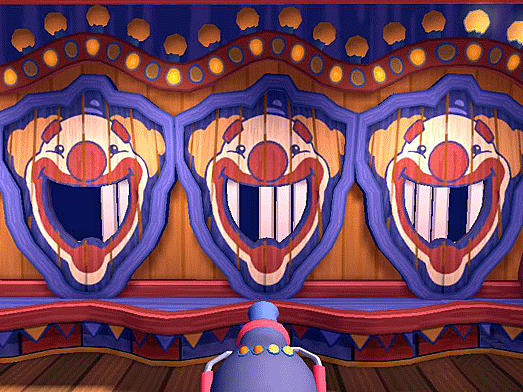
The "Roman target" game, created by Carl Woodin of Joplin, Missouri, in
the early 1940s, evolved from the old wheel of fortune. A Roman target
player would aim a cork gun at a moving target on the wheel to try to
stop the arrow at a particular prize, such as a comb, a squirt gun, a
whistle, or perhaps a $10 bill.
Another popular midway game was the “6-Cat” game. Here the customer
would throw balls at six stuffed cats standing on a rack. Sound simple?
It wasn’t, for nothing was a simple as it appeared on the midway. If a
player hit a cat too hard, it would fall off the rack onto a shelf, and
it didn't count. The trick, it seemed, was to hit the cat right on the
nose, and not too hard. What the player didn't know is that the operator
controlled a floating shelf behind the rack, and he had a lot of
practice catching cats on that shelf. This type of game became known as
an alibi game. The operator always had to come up with an alibi why the
player didn't win. These have been outlawed in most places.
The Scissor Bucket was a throwing game in which the ball had to rebound
from a target just right to fall into a bucket or circle. Hidden from
the player was a second operator, watching the sucker from behind a
two-way mirror, and controlling the tension on the target surface. The
hidden operator would make the ball bounce away or drop short, depending
on the strength of the throw.
Lee Moss of Hot Springs, Arkansas invented a type of gaming machine
called the Dragline. Using a claw, players could dig into trays of dimes
and silver dollars, but the government said a money-for-money game
constituted gambling, so it outlawed cash prizes. Also, the crane would
stop at a random spot and grab whatever was underneath. But the
government called that a game of chance. Originally, a person pulled a
cord to get it started, but later, coin slots replaced the operator. And
in the original, the prizes rested in seed corn, but carnival people
eventually grew tired of mice invading their machines during winter
storage, so they replaced corn with carpeting.
The Sideshow
Freak shows or sideshows are all but gone on the midway. Early versions
of these shows had their beginnings at English fairs of the early
Renaissance. But it was P.T. Barnum that made them popular in America.

People accused him of trickery, which brought Barnum notoriety. He
exhibited increasingly diverse oddities, such as giants, dwarfs, and
albinos. By the 1870s, museums like Barnum’s American Museum in New
York, sprang up across the nation, making human oddities the chief form
of entertainment. Soon these exhibits went on the road, becoming the
forerunners of the “sideshow.”

Most midways often had several sideshows, located in tents. One of the
main types of sideshow, popularly called a “freak show,” since human
oddities were usually among the exhibits, became known to “carnys” as a
“Ten-in-One.” This featured a number of acts, often arranged along a
platform, with the crowd moving from one to the other in sequence.
Because the show ran continuously, if a spectator entered the tent
during the magician’s act, for instance, the guide or “lecturer” would
lead him or her through the remaining nine acts and when the magician
appeared again, that was the signal to exit the show.
At the end of each act or exhibit, the lecturer would offer spectators a
true life booklet or photograph. Frequently giants sold huge finger
rings and midgets offered miniature bibles. Such an extra sale became
known as an "aftercatch."
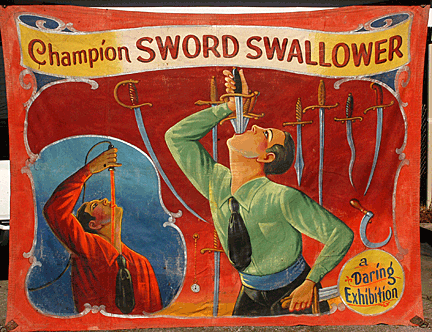 Meanwhile, outside, a "talker" or barker drummed up a new crowd, usually
with the assistance of one or more of the acts to provide a taste of
what was inside. He did his pitch on a bally platform, coming from the
word ballyhoo, meaning to promote sensationally. Meanwhile, outside, a "talker" or barker drummed up a new crowd, usually
with the assistance of one or more of the acts to provide a taste of
what was inside. He did his pitch on a bally platform, coming from the
word ballyhoo, meaning to promote sensationally.
Oddities and exotic acts featured in the Ten-in-One varied according to
the show and availability of performers. These can be divided into
categories: “born” human oddities, “made” freaks, “gaffed” or fake
freaks, those with a special skill, illusions, exotic animals, and
inanimate objects.
Carnies subdivided “born" human oddities into two types–those with an
obvious disfigurement and “anatomical wonders.” Midgets, like Barnum’s
Tom Thumb, giants, conjoined twins, like Barnum’s Chang and Eng, bearded
ladies, those with skin abnormalities, are good examples of the former.
Sideshow owners often imaginatively interpreted exhibits such as “The
Caterpillar Man” and “Dickie, the Penguin Boy.”
An "anatomical wonder" was a sideshow performer, usually perceived as a
human oddity, who did an act. James Morris, known as “The Elastic Skin
Man,” could stretch the skin of his cheek eight inches and pull his
chest skin to the crown of his head. Charles Tripp, "The Armless
Wonder," teamed up with Eli Bowen, "the Legless Wonder," to perform
amusing stunts like riding a bicycle built for two.
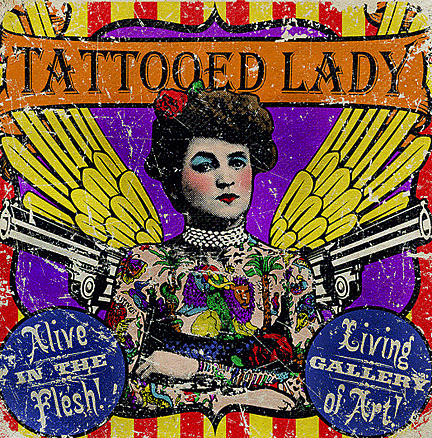 Tattooed people are good examples of the category of “made” freaks. One
of the most famous was Horace Ridler, a British ex-army officer who
decided to get tattooed all over with zebra-like stripes. Known as "The
Great Omi, The Zebra Man,” he claimed to have been forcibly tattooed by
New Guinea savages and became one of the highest paid sideshow
performers. Tattooed people are good examples of the category of “made” freaks. One
of the most famous was Horace Ridler, a British ex-army officer who
decided to get tattooed all over with zebra-like stripes. Known as "The
Great Omi, The Zebra Man,” he claimed to have been forcibly tattooed by
New Guinea savages and became one of the highest paid sideshow
performers.
Other "made" freaks include a Mortado, the “crucified man,” who had his
hands and feet pierced surgically. In the holes he concealed capsules of
red liquid that spouted forth when a men pounded spikes through them. He
eventually became “Mortado, the Human Fountain” at Coney Island,
utilizing a specially designed chair with plumbing fixtures.
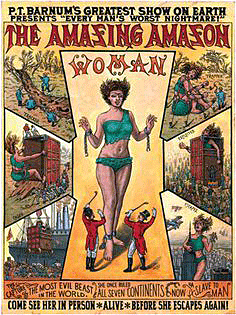 When the real thing wasn’t available, sideshow owners turned to
“gaffing” or faking freaks. Fake alligator men or women could be
produced by painting their bodies with a weak solution of glue and,
after it dried, having them twist to create the cracking effect of a
real skin condition called ichthyosis. When the real thing wasn’t available, sideshow owners turned to
“gaffing” or faking freaks. Fake alligator men or women could be
produced by painting their bodies with a weak solution of glue and,
after it dried, having them twist to create the cracking effect of a
real skin condition called ichthyosis.
Sometimes owners gaffed a “born” oddity to enhance it. Through the use
of makeup, William Durks, who had an eye and nostril on either side of a
growth in the center of his face, enhanced the effect by using makeup to
add an extra central "eye" and two "nostrils," becoming "The Man with
Three Eyes." Sideshow owners often exaggerated claims and fabricated
backgrounds. For instance, they subtracted inches from the height of
midgets and had giants wear lifts and tall hats.
Midway crowds loved performers with special skills, such as sword
swallowers, fire eaters and fire breathers, snake charmers,
contortionists, strong men, and torturists, who stuck themselves with
pins or lay on a bed of nails.
Illusionists
Illusions also drew spectators. Transformations, such as girl-to-gorilla
or skeletal-corpse- to-living-vampire, tempted spectators’ curiosity. An
illusion that was especially popular around the end of the 19th century
was an effect known to magicians and carnies as the "blade box." A young
woman would lie in a box intersected with a number of blades. Often for
an extra charge, spectators could come up on the platform and peer
inside.
The same oddities that affect humans also affect other
animals--three-legged sheep, natural hybrids such as a dog/racoon or a
zebra/donkey. These hybrids usually didn’t match their banners, which
showed the rear of one animal attached to the front of another, when, in
actuality, they were merely crossbreeds.
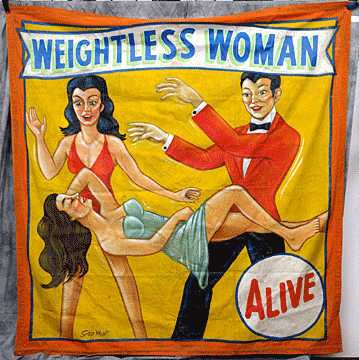 Sideshow owners also exhibited “curios”–a photograph of the world’s
largest horse or the world’s smallest preserved in a jar. Banners
distinguished the live exhibits from the curios with the word “Alive.” Sideshow owners also exhibited “curios”–a photograph of the world’s
largest horse or the world’s smallest preserved in a jar. Banners
distinguished the live exhibits from the curios with the word “Alive.”
People also paid to see inanimate objects, such as preserved human or
animal specimens, for example Barnum's "Feejee mermaid.” Various
sideshow mummies, including the alleged body of John Wilkes Booth,
appeared from time to time. And then there was the bullet-ridden car of
fugitives Bonnie and Clyde.
Midway collectibles span the gamut from the sublime to the ridiculous.
Handcrafted wheels used in the games of chance are some of the larger
items. Some of the most elaborate came from the 1930s to 1950s, the
heyday of the carnival midway.
Collectors also seek out chalkware prizes, hand-decorated horses, dogs,
ships, cartoon characters, risqué bikini figurines and more. Rare ones
can fetch $200 to $300 each in fine condition, but chalkware is
notoriously fragile and easy to chip, so the few that do turn up are
often damaged. Some have cross-over interest, because they're knock-offs
of pop culture characters such as Superman or the Lone Ranger.
Midway Art
Midway art is also popular. Decorations from carnival rides, known as
"monkey faces," are one of the more unique midway collectibles. And, of
course, there were the sideshow banners.
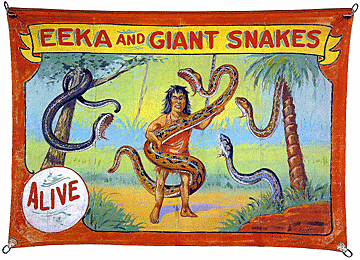 Since these were large, it’s more difficult for an individual collector
to display them. Fred Johnson of O. Henry Tent & Awning, Chicago was one
of the best banner artists. His sideshows banners depicted such human
oddities as The Rubber-Necked Lady in minute detail. Since these were large, it’s more difficult for an individual collector
to display them. Fred Johnson of O. Henry Tent & Awning, Chicago was one
of the best banner artists. His sideshows banners depicted such human
oddities as The Rubber-Necked Lady in minute detail.
The old-fashioned midway catered to the curiosity seeker in everyone.
Often a spectator would ask of an exhibit, “Is it real?” Showman Ward
Hall responded, "Oh, it's all real. Some of it's really real, some of
it's really fake, but it's all really good."
< Back to
Collectibles Archives Next
Article >
|
